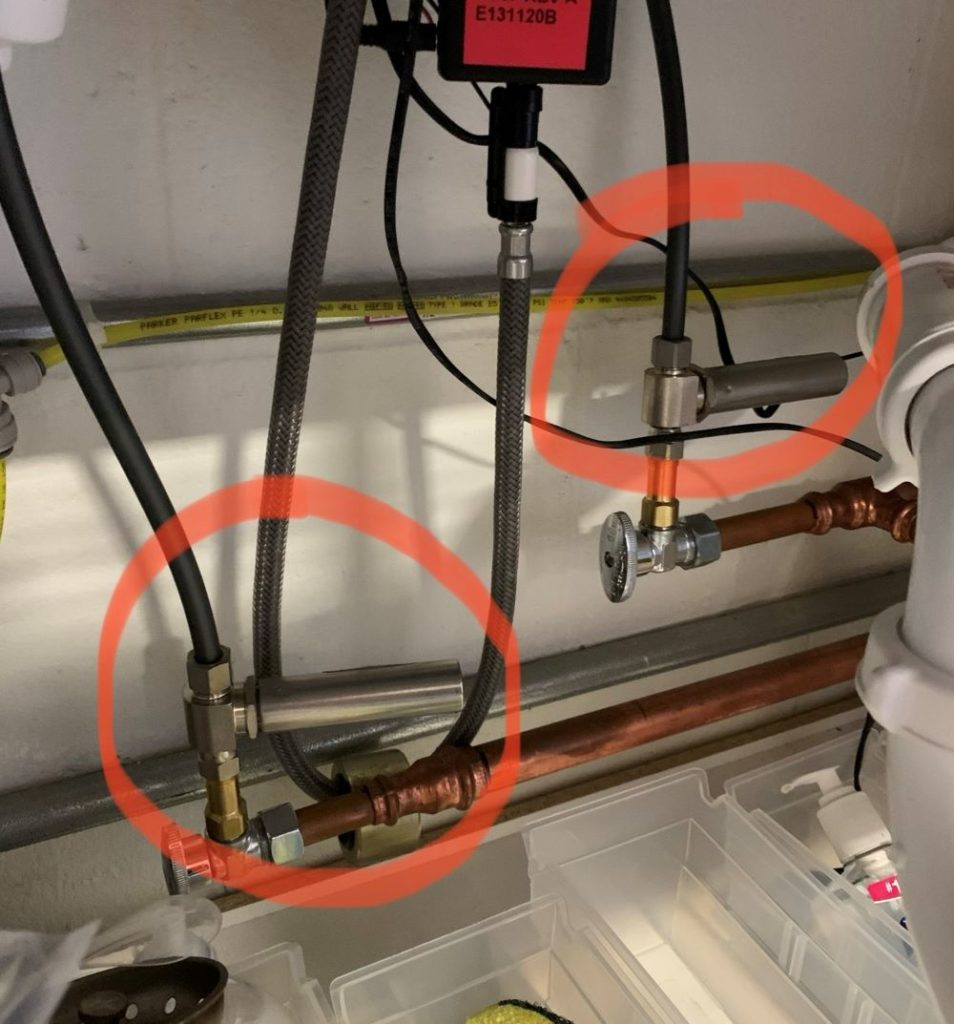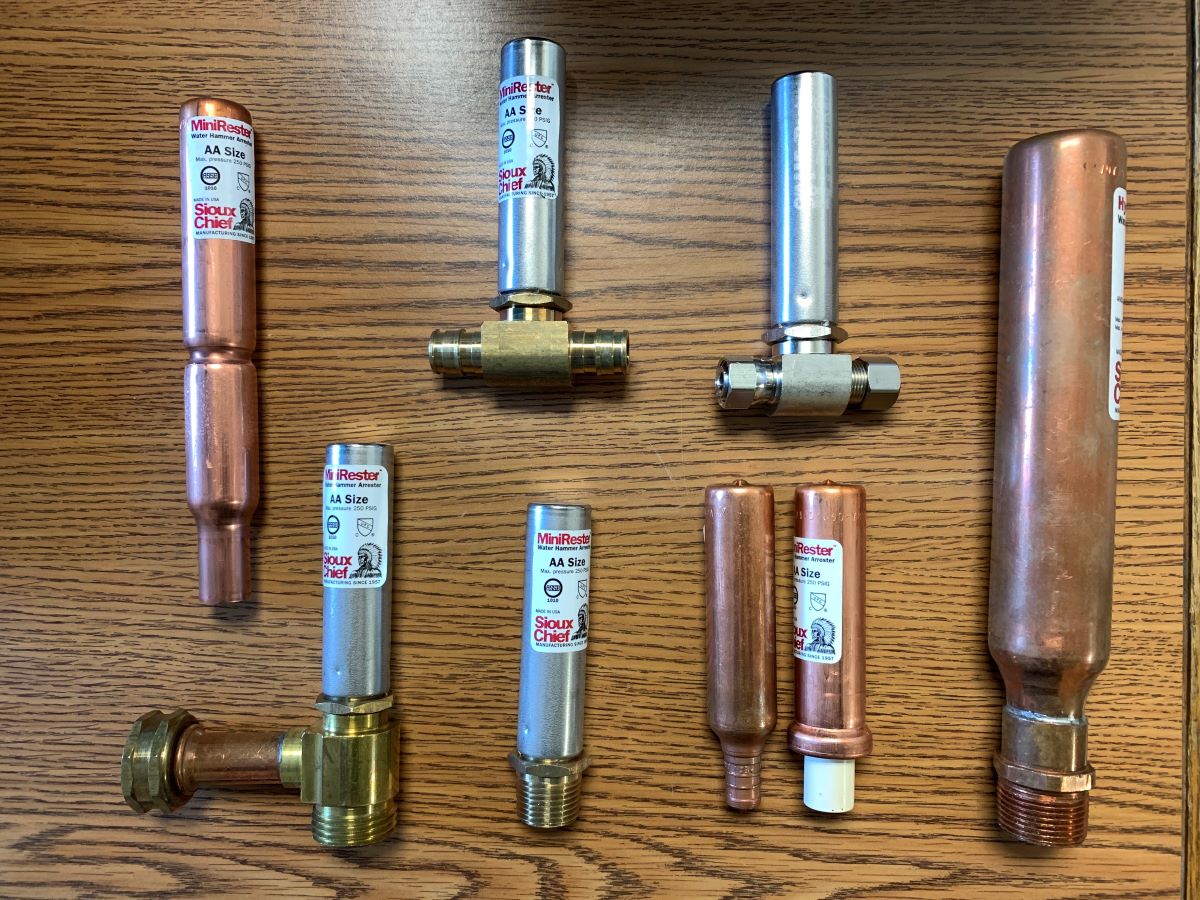Have you ever wondered how plumbers cure that hammer noise that you hear in your water pipes? Well this is where the air chamber comes in to play.
Air chambers are small lengths of pipe that are mounted on your water pipes, close to a fixture. They‘re made to stop hydraulic shock also known as water hammer. The air in the chamber compresses and absorbs the shock of water moving abruptly in your pipes. This all happens when a fixture shuts off the water quickly.
There is absolutely a variety of air chambers to choose from. Not all of them are created equally. Adding these air chambers to your existing plumbing can save you thousands of dollars. I’ll explain what I mean by that in this post.
Air Chambers are also known as…
Air chambers are called different things depending on what you were taught. Old school plumbers call them PPP’s. Air chambers are also known as hammer arrestors, shock arrestors, and mini arrestors to name a few. Throughout my post, I will be referring to air chambers as hammer arresters. Now let’s discuss exactly what water hammer is.
What is Water Hammer?
The Pressure surge from a valve shutting off abruptly changes the momentum of the water. When this happens your pipes move and shake and you hear a noise called water hammer. Water is a non-compressible fluid. We tend to forget but water is actually quite heavy. A gallon is about 8.33 pounds! Think of all the water in your plumbing system at home or even in a large commercial plumbing system. That can be a lot of water and the weight can add up very quickly.
Imagine the water flowing into your plumbing system. Then picture a valve from a fixture like a laundry faucet being shut off quickly. The water literally slams into the valve and reverberates. The water moves back against the flow and this causes pipes to move and shake. The change in momentum creates a spike in pressure. That can be detrimental to your plumbing system.
Why Air Chambers are Necessary
We want to mitigate water hammer. The first way to do that should be to try and slow the closure speed of the valve. This might not be possible depending on the fixture. For example, if a dishwasher shuts off you cant control the speed of that valve. The next best way to mitigate water hammer is with an air chamber device A.K.A a hammer arrester.
Water hammer shakes and moves plumbing systems and creates that audible water hammer noise. This not only can shift pipes but it beats up your plumbing joints, valves and fixtures. Here are some things that water hammer damages that you probably haven’t thought about.
The Main Products that Get Damaged from Water Hammer
- Water heaters
- Faucets
- Shower valves
- Fittings
- Backflow preventers
- Plumbing hangers or bracing
I want to expand briefly on each of these products. Let’s start with Water Heaters. Your water heater can fail from excessive and uncontrolled water hammer. The shock wave of water that travels through your tank rapidly and over time can cause your tank lining to crack. If your tank cracks that can cause rusting and leaking and ultimately failure. As you most likely know water heaters can be very costly to switch out.
Faucets can be damaged from water hammer as well. When a surge of water comes through, your faucet cartridge is what typically gets damaged. Your faucet cartridge can crack from water hammer. Hopefully, you can find your cartridge easily, and hopefully, it’s not too expensive to fix.
A shower valve is susceptible to damage from water hammer too. Increased pressure can wreck your shower valve in many ways. In many cases, if the valve is old you won’t be able to get a replacement cartridge. You might be forced to open up walls and put in a new shower valve.
Backflow preventers are at risk from water hammer as well. Downstream surges of water can create excess dumping of water from your backflow preventer. Backflow preventers are built tuff but they have a lot of internal parts. When water hammer is involved they can be exposed to extreme wear from that kind of pressure. Fixing these units is costly and can take a decent amount of time to work on even by a licensed professional.
Not so Obvious Products that can be Damaged
The pipes and fittings that make up your plumbing system can be damaged too. When your pipes shake and move this creates external pressure on plumbing joints. The joints are typically elbows and tee’s. If one lets loose the damage can be extensive. Water hammer in the plumbing system creates high internal pressure that can exceed your pipe and fittings pressure rating. If that happens fittings can fail that way as well.
Hangers and brackets. This one by now is probably pretty obvious but it’s worth mentioning. When you have water hammer, and the pipes are banging around that can dislodge plumbing system hangers and brackets. When that happens that can create loud noises when the pipes are not secured. If your plumbing system is hanging without hangers it’s at greater risk of totally failing.
The Mechanics of an Air Chamber.
It’s a fairly simple device, the hammer arrestor requires no maintenance and no charging of air.
Internally the hammer arrestor has a piston that’s sealed inside the copper pipe with a few o-rings. The space thats above the piston, is charged with air and below the piston, it’s exposed to the plumbing water. So as a shock wave from a fast-closing valve moves through the pipes and to the hammer arrestor that causes the piston to rise and compress the air. As a result, when that compression occurs it’s absorbing the energy from the shock that was caused by the initial fast-closing valve. Once the energy is dissolved it then releases the piston and it waits for the water hammer to occur again.
Where Air Chambers are Typically Located?
Air chambers are typically located on the plumbing pipe in close proximity to a plumbing fixture. Hammer arresters need to be installed within 6 feet of the quick closing valve. Hammer arresters can be installed at any angle. Which is really nice for the installer.
Plumbing fixtures that should have a hammer arrester installed close to them are:
Dishwashers
Washing Machines
Tub and shower valves
Sensor faucets
Ice Makers

These are some of the big items that most likely will need a hammer arrester. Of course, you could have other fixtures that require one as well. I always recommend speaking to a licensed professional about your plumbing concerns.
What Types of Air Chambers are there?
There are so many different types of air chambers out there. They make really generic ones and they make fixture specific ones too. I recommend a well-made hammer arrester. Cold-formed and spin closed ends mean that they have no welded seams. That means that there is one less joint that could leak. That might be something that only a really good contractor cares about. It’s something to consider if you purchase one yourself.
The vast array of arresters include 1/2″ copper sweat, 1/2″ MIP, 3/4″ Hose connection for a washer machine. They also have 3/8″ compression tee’s for a dishwasher. They have a toilet and tub and shower specific hammer arresters too. There’s also cpvc and expansion and crimp pex straight arrestors. The list goes on and on.
The main point here is that there is an arrester for every application. That makes the installation process way easier.
Final Thoughts
Hopefully, you’ve learned some relevant information about air chambers/hammer arresters. You can see that they are very useful to have as a part of your plumbing system. If your home has any signs of water hammer please take that seriously. Professional plumbers will be able to not only install them where they are needed but they will be able to size them correctly as well. Sizing them can be tricky and that might have to be for another post.
If you have comments and would like me to write about anything plumbing related please let me know. Thanks so much for taking the time to be here.
